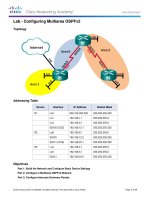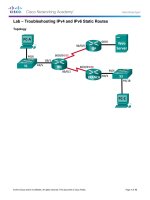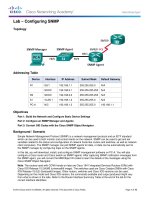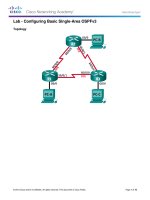29 HSRP hot standby router protocol kho tài liệu bách khoa
Bạn đang xem bản rút gọn của tài liệu. Xem và tải ngay bản đầy đủ của tài liệu tại đây (504.18 KB, 15 trang )
HSRP (Hot Standby Router Protocol)
Hot Standby Router Protocol (HSRP) is a Cisco proprietary redundancy protocol for establishing a faulttolerant default gateway, and has been described in detail in RFC 2281.
The protocol establishes a framework between network routers in order to achieve default gateway
failover if the primary gateway becomes inaccessible, in close association with a rapid-converging
routing protocol like EIGRP or OSPF. By multicasting packets, HSRP sends its hello messages to the
multicast address 224.0.0.2 (all routers) for version 1, or 224.0.0.102 for version 2, using UDP port 1985,
to other HSRP-enabled routers, defining priority between the routers. The primary router with the
highest configured priority will act as a virtual router with a pre-defined gateway IP address and will
respond to the ARP request from machines connected to the LAN with the MAC address
0000.0C07.ACXX (or 0000.0C9F.FXXX for HSRPv2) where X will be hex representation of the (decimal)
group ID. If the primary router should fail, the router with the next-highest priority would take over the
gateway IP address and answer ARP requests with the same MAC address, thus achieving transparent
default gateway failover.
HSRP is not a routing protocol as it does not advertise IP routes or affect the routing table in any way.
Figure 1 HSRP
Terminology
HSRP (Hot Standby Router Protocol)
HSRP for IPv4
HSRP routers communicate with each other by exchanging HSRP hello packets. These packets are sent
to the destination IP multicast address 224.0.0.2 (reserved multicast address used to communicate to all
routers) on UDP port 1985. The active router sources hello packets from its configured IP address and
the HSRP virtual MAC address while the standby router sources hellos from its configured IP address and
the interface MAC address, which might be the burned-in address (BIA). The BIA is the last six bytes of
the MAC address that is assigned by the manufacturer of the network interface card (NIC).
Because hosts are configured with their default router as the HSRP virtual IP address, hosts must
communicate with the MAC address associated with the HSRP virtual IP address. This MAC address is a
virtual MAC address, 0000.0C07.ACxy, where xy is the HSRP group number in hexadecimal based on the
respective interface. For example, HSRP group 1 uses the HSRP virtual MAC address of 0000.0C07.AC01.
Hosts on the adjoining LAN segment use the normal Address Resolution Protocol (ARP) process to
resolve the associated MAC addresses.
HSRP version 2 uses the new IP multicast address 224.0.0.102 to send hello packets instead of the
multicast address of 224.0.0.2, which is used by version 1. HSRP version 2 permits an expanded group
number range of 0 to 4095 and uses a new MAC address range of 0000.0C9F.F000 to 0000.0C9F.FFFF.
HSRP for IPv6
IPv6 hosts learn of available IPv6 routers through IPv6 neighbor discovery (ND) router advertisement
(RA) messages. These messages are multicast periodically, or might be solicited by hosts, but the time
delay for detecting when a default route is down might be 30 seconds or more. HSRP for IPv6 provides a
much faster switchover to an alternate default router than the IPv6 ND protocol provides, less than a
second if the milliseconds timers are used. HSRP for IPv6 provides a virtual first hop for IPv6 hosts.
When you configure an IPv6 interface for HSRP, the periodic RAs for the interface link-local address stop
after IPv6 ND sends a final RA with a router lifetime of zero. No restrictions occur for the interface IPv6
link-local address. Other protocols continue to receive and send packets to this address.
IPv6 ND sends periodic RAs for the HSRP virtual IPv6 link-local address when the HSRP group is active.
These RAs stop after a final RA is sent with a router lifetime of 0 when the HSRP group leaves the active
state. HSRP uses the virtual MAC address for active HSRP group messages only (hello, coup, and
redesign).
HSRP for IPv6 uses the following parameters:
HSRP version 2
UDP port 2029
Virtual MAC address range from 0005.73A0.0000 through 0005.73A0.0FFF
HSRP (Hot Standby Router Protocol)
Multicast link-local IP destination address of FF02::66
Hop limit set to 255
This protocol is used for Gateway redundancy or high availability
1. Cisco Proprietary (1994)
2. Hello interval 3 sec
3. Hold interval 10 sec
4. It use UDP port number 1985
5. It sends multicast hellos via 224.0.0.2
6. Default Priority is 100
7. Default Preempt Disable
8. Default decrement in priority using track 10
9. It supports two types of authentication (MD-5 & Txt).
10. HSRP virtual Mac 0000.0c07.acxx (XX is group ID)
11. It has two versions (v1 & v2)
12. It has built in track command
(Note: Maximum Group we can create in HSRP is 0 to 255)
HSRP Authentication
HSRP message digest 5 (MD5) algorithm authentications protects against HSRP-spoofing software and
uses the industry-standard MD5 algorithm for improved reliability and security. HSRP includes the IPv4
or IPv6 address in the authentication TLVs.
HSRP Messages
Routers that are configured with HSRP exchange the following three types of multicast messages:
Hello- The hello message conveys the HSRP priority and state information of the router to other
HSRP routers.
Coup- When a standby router wants to assume the function of the active router, it sends a coup
message.
Resign- A router that is the active router sends this message when it is about to shut down or
when a router that has a higher priority sends a hello or coup message.
HSRP Load Sharing
HSRP allows you to configure multiple groups on an interface. You can configure two overlapping IPv4
HSRP groups to load share traffic from the connected hosts while providing the default router
HSRP (Hot Standby Router Protocol)
redundancy expected from HSRP. Figure 19-2 shows an example of a load-sharing HSRP IPv4
configuration.
Figure 2 Two
routers A and B and two HSRP groups. Router A is the active router for group A but is the
standby router for group B. Similarly, router B is the active router for group B and the standby router
for group A. If both routers remain active, HSRP load balances the traffic from the hosts across both
routers. If either router fails, the remaining router continues to process traffic for both hosts.
(Note: HSRP for IPv6 load-balances by default. If there are two HSRP IPv6 groups on the subnet, then
hosts learn of both groups from their router advertisements and choose to use one so that the load is
shared between the advertised routers.)
HSRP (Hot Standby Router Protocol)
Object Tracking and HSRP
You can use object tracking to modify the priority of an HSRP interface based on the operational state of
another interface. Object tracking allows you to route to a standby router if the interface to the main
network fails.
Two objects that you can track are the line protocol state of an interface or the reachability of an IP
route. If the specified object goes down, Cisco NX-OS reduces the HSRP priority by the configured
amount.
Configuring HSRP Object Tracking
You can configure an HSRP group to adjust its priority based on the availability of other interfaces or
routes. The priority of a device can change dynamically if it has been configured for object tracking and
the object that is being tracked goes down.
The tracking process periodically polls the tracked objects and notes any value change. The value change
triggers HSRP to recalculate the priority. The HSRP interface with the higher priority becomes the active
router if you configure the HSRP interface for preemption.
SUMMARY STEPS
1. configure terminal
2. track object-id interface interface-type number {{ip | ipv6} routing | line-protocol}
3. track object-id {ip | ipv6} route ip-prefix/length reachability
4. interface interface-type slot/port
5. hsrp group-number [ipv4 | ipv6]
6. priority [value]
7. track object-number [decrement value]
8. preempt [delay [minimum seconds] [reload seconds] [sync seconds]]
9. (Optional) show hsrp interface interface-type number
10. (Optional) copy running-config startup-config
This example shows how to configure HSRP object tracking on Ethernet 1/2:
switch# configure terminal
switch(config)# track 1 interface ethernet 2/2 line-protocol
switch(config)# interface ethernet 1/2
switch(config-if)# hsrp 2
switch(config-if-hsrp)# track 1 decrement 20
switch(config-if-hsrp)# copy running-config startup-config
HSRP (Hot Standby Router Protocol)
HSRP Roles
1. Active
2. Stand by
HSRP States
(i)
(ii)
(iii)
(iv)
(v)
Disabled
Init
Listening
Speaking
Stand by
Active- A router which gives the reply of ARP request of clients for gateway.
Active Requirements–
(i)
(ii)
Higher Priority
Higher IP
Stand by- Backup to active. The router which has the higher priority would be active.
Preempt by default is disabled; we need to enable it, once it will enable it force higher priority
router to become active.
Figure 3 HSRP
Role Selection
HSRP (Hot Standby Router Protocol)
Prerequisites for HSRP
(i)
(ii)
You must enable the HSRP feature in a device before you can configure and enable any HSRP
groups.
If you configure VDCs, install the Advanced Services license and enter the desired VDC (see
the Cisco Nexus 7000 Series NX-OS Virtual Device Context Configuration Guide, Release 5.x).
Guidelines and Limitations for HSRP
HSRP has the following configuration guidelines and limitations:
You must configure an IP address for the interface that you configure HSRP on and enable that
interface before HSRP becomes active.
You must configure HSRP version 2 when you configure an IPv6 interface for HSRP.
For IPv4, the virtual IP address must be in the same subnet as the interface IP address.
We recommend that you do not configure more than one first-hop redundancy protocol on the
same interface.
HSRP version 2 does not interoperate with HSRP version 1. An interface cannot operate both
version 1 and version 2 because both versions are mutually exclusive. However, the different
versions can be run on different physical interfaces of the same router.
You cannot change from version 2 to version 1 if you have configured groups above the group
number range allowed for version 1 (0 to 255).
HSRP for IPv4 is supported with BFD. HSRP for IPv6 is not supported with BFD.
Cisco NX-OS removes all Layer 3 configurations on an interface when you change the interface
VRF membership, port channel membership, or when you change the port mode to Layer 2.
If you configure virtual MAC addresses with vPC, you must configure the same virtual MAC
address on both vPC peers.
For mixed-chassis configurations where the vPC peer link is configured on an F-series module,
configure the vPC peer gateway exclude option to exclude the Layer 3 backup route that
traverses the vPC peer link.
You cannot use the HSRP MAC address burned-in option on a VLAN interface that is a vPC
member.
If you have not configured authentication, the show hsrp command displays the following string:
Authentication text "cisco"
This is the default behavior of HSRP as defined in RFC 2281:
If no authentication data is configured, the RECOMMENDED default value is 0x63 0x69 0x73
0x63 0x6F 0x00 0x00 0x00.
HSRP (Hot Standby Router Protocol)
Default Settings
Parameters
Default
HSRP
Disabled
Authentication
Enabled as text for version 1, with cisco as the password
HSRP version
Version 1
Preemption
Disabled
Priority
100
Virtual MAC address
Derived from HSRP group number
Enabling HSRP
You must globally enable HSRP before you can configure and enable any HSRP groups.
To enable the HSRP feature in a VDC, use the following command in global configuration mode:
Command
Purpose
feature hsrp
Example:
switch(config)# feature hsrp
Enables HSRP.
To disable the HSRP feature in a VDC and remove all associated configurations, use the following
command in global configuration mode:
Command
Purpose
no feature hsrp
Example:
switch(config)# no feature hsrp
Disables HSRP for all groups in a VDC.
Configuring the HSRP Version
You can configure the HSRP version. If you change the version for existing groups, Cisco NX-OS
reinitializes HSRP for those groups because the virtual MAC address changes. The HSRP version applies
to all groups on the interface.
HSRP (Hot Standby Router Protocol)
(Note: IPv6 HSRP groups must be configured as HSRP version 2.)
To configure the HSRP version, use the following command in interface configuration mode:
Command
Purpose
hsrp version {1 | 2}
Example:
switch(config-if)# hsrp version 2
Configures the HSRP version. Version 1 is the default.
Configuring an HSRP Group for IPv4
You can configure an HSRP group on an IPv4 interface and configure the virtual IP address and virtual
MAC address for the HSRP group.
SUMMARY STEPS
1.
2.
3.
4.
5.
6.
7.
8.
9.
configure terminal
interface type number
ip ip-address/length
hsrp group-number [ipv4]
ip [ip-address [secondary]]
exit
no shutdown
(Optional) show hsrp [group group-number] [ipv4]
(Optional) copy running-config startup-config
The following example shows how to configure an HSRP group on Ethernet 1/2:
switch# configure terminal
switch(config)# interface ethernet 1/2
switch(config-if)# ip 192.0.2.2/8
switch(config-if)# hsrp 2
switch(config-if-hsrp)# ip 192.0.2.1
switch(config-if-hsrp)# exit
switch(config-if)# no shutdown
switch(config-if)# copy running-config startup-config
Configuring an HSRP Group for IPv6
You can configure an HSRP group on an IPv6 interface and configure the virtual MAC address for the
HSRP group.
HSRP (Hot Standby Router Protocol)
When you configure an HSRP group for IPv6, HSRP generates a link-local address from the link-local
prefix. HSRP also generates a modified EUI-64 format interface identifier in which the EUI-64 interface
identifier is created from the relevant HSRP virtual MAC address.
There are no HSRP IPv6 secondary addresses.
SUMMARY STEPS
1.
2.
3.
4.
5.
6.
7.
8.
9.
10.
configure terminal
interface type number
ipv6 address ipv6-address/length
hsrp version 2
hsrp group-number ipv6
ip [ipv6-address [secondary]]
ip autoconfig
no shutdown
(Optional) show hsrp [group group-number] [ipv6]
(Optional) copy running-config startup-config
This example shows how to configure an IPv6 HSRP group on Ethernet 3/2:
switch# configure terminal
switch(config)# interface ethernet 3/2
switch(config-if)# ipv6 address 2001:0DB8:0001:0001:/64
switch(config-if)# hsrp 2 ipv6
switch(config-if-hsrp)# exit
switch(config-if)# no shutdown
switch(config-if)# copy running-config startup-config
Example of HSRP
R1 (config) #int fa0/0
R1 (config-if) #ip add 192.168.101.2 255.255.255.0
R1 (config-if) #no shut
R1 (config-if) #int s0/0
R1 (config-if) #ip add 192.168.1.1 255.255.255.0
R1 (config-if) #no shut
R1 (config) #router ei 100
R1 (config-router) #no auto
R1 (config-router) #network 0.0.0.0
HSRP (Hot Standby Router Protocol)
Ho (config) #int fa0/0
Ho (config-if) #ip add 192.168.102.1 255.255.255.0
Ho (config-if) #no shut
Ho (config-if) #int s0/0
Ho (config-if) #ip add 192.168.1.2 255.255.255.0
Ho (config-if) #no shut
Ho (config-if) #int s0/1
Ho (config-if) #ip add 192.168.2.1 255.255.255.0
Ho (config-if) #no shut
Ho (config-if) #router ei 100
Ho (config-router) #no auto
Ho (config-router) #network 0.0.0.0
R2 (config) #int fa0/0
R2 (config-if) #ip add 192.168.101.3 255.255.255.0
R2 (config-if) #no shut
HSRP (Hot Standby Router Protocol)
R2 (config-if) #int s0/0
R2 (config-if) #ip add 192.168.2.2 255.255.255.0
R2 (config-if) #no shut
R2 (config-if) #router ei 100
R2 (config-router) #no auto
R2 (config-router) #network 0.0.0.0
Ho #sh ip route
R1#sh ip int br
R2#sh ip int br
Now we will provide the IP add to the PC, which is 192.168.101.10. And computer Gateway would
192.168.101.1.
Right now 192.168.101.1 (computers default gateway) doesn’t exist anywhere.
Computer #ping 192.168.102.1
Unsuccessful
Now we will provide this virtual ip
R1 (config) #int fa0/0
R1 (config-if) #standby 1 ip 192.168.101.1
R2 (config) #int fa0/0
R2 (config-if) #standby 1 ip 192.168.101.1
(Here 1 means Group 1)
R1#sh standby
State is active, Group 1, Hello 3 sec, Hold 10 sec
Virtual Mac – 0.0.0.0:0c07:ac01
Preempt disabled, Default Priority 100
R2#sh standby
Computer #tracert 192.168.102.1
Now here we will shut down the interface f0/0 of R1
R1 (config) #int fa0/0
R1 (config-if) #shut
HSRP (Hot Standby Router Protocol)
R2 will immediately become active
Computer # ping 192.168.102.1
Now we will up the R1s f0/0
R1 (config) #int fa0/0
R1 (config-if) #no shut
R1#sh standby
Now we can see R1 is in standby mode. Now we will shut the fa0/0 of R2
R2 (config) #int fa0/0
R2 (config-if) #shut
R1#sh standby
Here we can see state is active
R2 (config) #int fa0/0
R2 (config-if) #no shut
Now here we can see R1 is active, but we want to make R2 as active. For that we will change the
Priority
R2 (config) #int fa0/0
R2 (config-if) #standby 1 priority 101
R2 (config-if) #standby 1 preempt
Here we increased the priority which was by default 100, and then enabled preempt which will force the
high priority router to become active.
R2#sh standby
Active
Now if we want to make the R1 active then we increased the R1s priority and enable the Preempt.
R1 (config) #int fa0/0
R1 (config-if) #standby 1 priority 102
R1 (config-if) #standby 1 preempt
R1#sh standby
Active
HSRP (Hot Standby Router Protocol)
Now here what we can see if the R1s f0/0 would down then R2s f0/0 would become active but if the R1s
S0/0 would down then what will happen? Data will move first on R1 and then it will reach on switch,
after that it will go on R2.
R1 (config) #int s0/0
R1 (config-if) #shut
Computer# tracert 192.168.102.1
Now here we want, if the R1s s0/0 is down then data should immediately forward via R2.
R1 (config) #int s0/0
R1 (config-if) #no shut
R1 (config-if) #int fa0/0
R1 (config-if) #standby 1 track s0/0
All the command will run on LAN Link.
Here if the serial link will down then track will decrement 10 in priority.
R1 (config) #int s0/0
R1 (config-if) #shut
R1#sh standby
Priority 92 (10 decreased)
Computer# tracert 192.168.102.1
Now data will go directly via R2
R1 (config) #int s0/0
R1 (config-if) #no shut
R1#sh standby
Priority 102
R1#sh run config int fa0/0
Now here if we want load balancing
R2 (config) #int fa0/0
R2 (config-if) #standby 2 ip 192.168.101.4
R2 (config-if) #standby 2 priority 101
R2 (config-if) #standby 2 preempt
R2 (config-if) #standby 2 track s0/0
R2#sh run int fa0/0
R1 (config) #int fa0/0
HSRP (Hot Standby Router Protocol)
R1 (config-if) #standby 2 ip 192.168.101.4
R1 (config-if) #standby 2 preempt
R1#sh run int fa0/0
R1 (config) #int s0/0
R1 (config-if) #shut
R2#sh standby
R1 (config) #int s0/0
R1 (config-if) #no shut
R1#sh standby
R2 (config) #int s0/0
R2 (config-if) #shut
R1#sh standby
R2 (config) #int s0/0
R2 (config-if) #no shut
Computer# tracert 192.168.102.1









